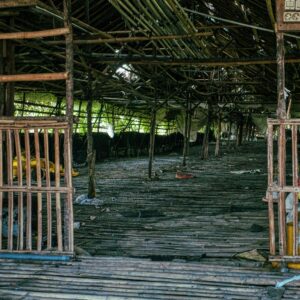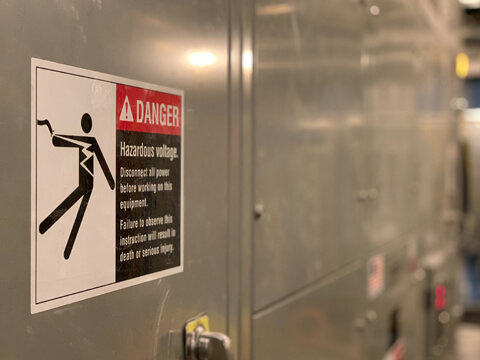How is Bamboo Used in Construction?
Bamboo has many uses in construction, including but not limited to structural elements, flooring, furniture, wall and ceiling panels, and as reinforcement for concrete. and roofing. Its natural  characteristics, such as strength, flexibility, and durability, make it suitable for various construction applications.
characteristics, such as strength, flexibility, and durability, make it suitable for various construction applications.
- Structural elements – Bamboo has been used as a structural element in construction for centuries. Bamboo poles can be used as vertical columns and horizontal beams to create the basic structure of a building. Their high tensile strength, coupled with their lightweight nature, allows them to support significant loads. It is also utilized as trusses to support roofs and floors.
- Flooring – Flooring is one of the most popular uses for bamboo in construction. Bamboo flooring is durable, attractive, and eco-friendly, making it an increasingly popular choice for homes and commercial spaces.
- Wall and ceiling panels – Another decorative use for bamboo is wall and ceiling paneling. They are available in different shades, textures, and patterns, which allows for a wide range of customization options.
- Reinforcement for concrete – Bamboo can be used as a reinforcement material in concrete. It has a high tensile strength, like that of mild steel, which allows it to provide additional support to the structure. To learn more about reinforced concrete check out our white paper: Structural Engineering: Elements of Every Structure
- Roofing: Bamboo can be split and used to create lightweight, flexible, and durable roofing materials.
- Furniture – Bamboo furniture can come in a variety of styles, from modern and minimalist to traditional and ornate. It can be used to create everything from chairs and tables to bookcases and bed frames.
Is Bamboo Construction Environmentally Friendly?
There are several reasons why bamboo is considered environmentally friendly. Bamboo construction has a lower carbon footprint than most traditional construction materials such as concrete, steel, and lumber. Additionally, Bamboo absorbs large amounts of carbon dioxide during its growth, helping to reduce greenhouse gas emissions. In comparison, the production of conventional building materials, such as steel or concrete, generates significant carbon emissions. Bamboo construction also produces less waste than other traditional materials as it can be used in its entirety, from its shoots to its leaves, while any leftover material can be repurposed or used as biomass for energy production. Bamboo plants themselves have a fast growth rate, as bamboo is one of the fastest-growing plants on Earth. Some species can grow up to 3 feet (90 cm) per day, making it a highly renewable and sustainable resource.
Despite these advantages, it must be acknowledged that the use of chemical treatments to prevent pests and decay, as well as the need for proper harvesting and curing techniques, can affect the overall environmental impact. However, when used and sources responsibly, bamboo can be a sustainable and more environmentally friendly alternative to traditional construction materials.
What are the Advantages of Bamboo Construction?
Like many non-traditional large scale construction materials, bamboo has gained popularity in recent years due to its numerous advantages. Some of the key benefits of using bamboo as a construction material include:
- Sustainability – Bamboo is a fast-growing plant making it an easily renewable and sustainable building material especially when compared to traditional construction materials like hardwoods.
- Strength and durability – Bamboo has a high strength-to-weight ratio and is superior to many hardwoods in compressive strength. Properly treated and maintained bamboo can last for many years both inside the structure and outside.
- Cost effectiveness – Depending on where construction is taking place, cost-effectiveness can make bamboo construction more accessible to communities with limited financial resources.
- Versatility – Bamboo can be cut, shaped, and joined easily, which makes it useful for several different applications.
What are the Disadvantages of Bamboo Construction?
 As will all good things, bamboo construction also comes with some downsides, or pitfalls. The primary issue with bamboo construction is that once installed bamboo paneling, structural elements, flooring, roofing, and furniture are all high maintenance especially when compared to traditional construction materials such as steel, lumber, and concrete. For example, Prior to construction, bamboo should be properly treated to prevent insect infestation and decay. This process usually involves soaking bamboo in a boron solution, which makes it unappealing to insects, or using traditional methods like smoking or heat treatment. Bamboo is also sensitive to moisture, as a hygroscopic material, it can absorb moisture from the environment, which can lead to swelling, shrinking, or warping. This must be guarded against and requires the bamboo io be well-ventilated, and regularly inspected.
As will all good things, bamboo construction also comes with some downsides, or pitfalls. The primary issue with bamboo construction is that once installed bamboo paneling, structural elements, flooring, roofing, and furniture are all high maintenance especially when compared to traditional construction materials such as steel, lumber, and concrete. For example, Prior to construction, bamboo should be properly treated to prevent insect infestation and decay. This process usually involves soaking bamboo in a boron solution, which makes it unappealing to insects, or using traditional methods like smoking or heat treatment. Bamboo is also sensitive to moisture, as a hygroscopic material, it can absorb moisture from the environment, which can lead to swelling, shrinking, or warping. This must be guarded against and requires the bamboo io be well-ventilated, and regularly inspected.
Conclusion
Although bamboo construction may require more maintenance than traditional large-scale construction materials, it can still be strong and durable if well cared for. The low environmental impact, cost-effectiveness, and renewability of bamboo make it an attractive choice for sustainable construction projects.






